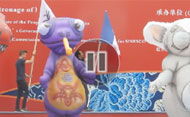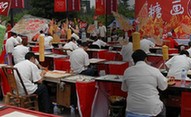Water-releasing festival
In 2015, with the help of the festival, its tourism industry is expected to attract more than 20 million tourists, reap 16 billion yuan in revenue and offer more than 160,000 job opportunities, according to the city's 2008-2020 master plan.
This blueprint includes plans to develop Dujiangyan into an international tourism city.
An economic pillar of the city, the tourism industry at one point created as much as 51.3 percent of its GDP and employed over 200,000 people before the earthquake in 2008, which damaged more than 80 percent of urban buildings and 95 percent of rural and mountainous houses in Dujiangyan.
Four years later, the city has largely bounced back through resilience and hard work. Fueled by the time-honored tradition of the water-releasing festival, Dujiangyan is now making further headway towards its goals.
About Dujiangyan
Annual flooding of the Min River was a constant threat to those who lived on its banks during the Warring States period (406-221 BC). While the easiest solution would have been to build a dam, military vessels still needed to be able to move along the waterway, so instead the government of the time created a levee that redirected part of the river. The excess water was redirected into the Chengdu Plain and became Dujiangyan. As a result, the floods abated and Sichuan became China's most agriculturally productive region. Dujiangyan became recognized as a UNESCO World Heritage Site in 2000.







